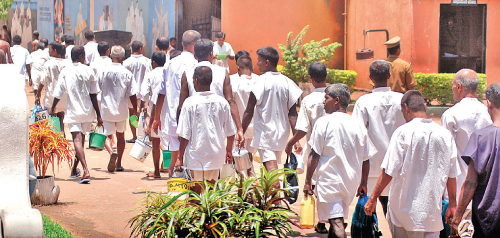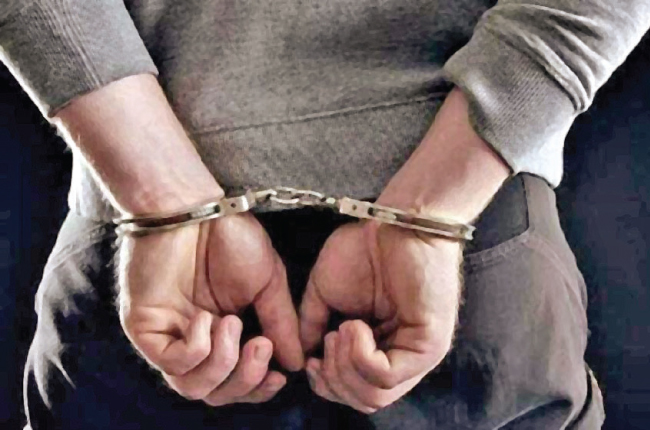In order to determine the elements essential for the safe transport of inmates, it is important to establish a general definition of correctional security. The term ‘correctional security’ is defined as the barriers and obstacles in place as a means of securing inmates. Ensuring that Prison/Police transports are conducted in the safest manner possible is an issue of life and death. Not only are the lives of officers at stake, but the safety of the public is put at ![]() risk when transports go wrong. The recommended approach for high-risk transport involves pre-operational planning, tactical delivery and post-operation evaluation. Let’s pause to understand an example – The US. Marshal’s service completes over 260,000 prisoner movements per year. A network of aircraft, cars, vans and buses accomplishes these coordinated security movements. Sri Lanka with its history of corruption, political interference, Police inefficiency and negligent
risk when transports go wrong. The recommended approach for high-risk transport involves pre-operational planning, tactical delivery and post-operation evaluation. Let’s pause to understand an example – The US. Marshal’s service completes over 260,000 prisoner movements per year. A network of aircraft, cars, vans and buses accomplishes these coordinated security movements. Sri Lanka with its history of corruption, political interference, Police inefficiency and negligent  attitudes will struggle to reach this level of professionalism, in this subject matter.
attitudes will struggle to reach this level of professionalism, in this subject matter.
A few days ago the nation was shocked when a Police Constable willfully loosened the handcuffs of a high-risk prisoner at the CID headquarters. This Police Constable knowingly put the lives of STF officers present into danger. Such dirty individuals are a disgrace to the Police uniform. Thankfully due to the tough training and top fitness levels maintained in the STF, that single officer was able to restrain the dangerous prisoner.
Because the very nature of inmate (prisoner) transport introduces vulnerability by removing security barriers, it’s vital that best practices are followed in order to address security risks. There is concern today about the safety of staff and civilians within Court premises. One trending practice overseas is to conduct virtual Court hearings. This eliminates the cost and risk of prison transport.
The very location of Sri Lanka’s main prison – Welikada, is a topic of heated debate. The prison headquarters is located right opposite Wesley College, one of the leading boy’s schools in Sri Lanka with a magnificent history of 150 years. The main access way to the prison is only a few feet away from the school’s main gate. On the other side, a few metres away is the nation’s apex childcare hospital. Not a location for a major prison. Hundreds of prisoner movements are done via this public road. During the 2012 prison riot, prisoners broke into the Welikada armoury. They indiscriminately fired automatic weapons at responding Police. If this incident had taken place during school hours, what a terrible threat it would have created. It is time the responsible Ministry for Prison Reforms relocates the overcrowded Welikada prison complex out of Colombo.
Transport safety
 Prior to departing a facility with an inmate, transport officers should be aware of several factors. Operational delivery involves the detailing of special requirements for the transport, special interagency considerations, team briefing, intelligence, escape risk-assessment and even potential for prisoners’ assassination.
Prior to departing a facility with an inmate, transport officers should be aware of several factors. Operational delivery involves the detailing of special requirements for the transport, special interagency considerations, team briefing, intelligence, escape risk-assessment and even potential for prisoners’ assassination.
In February 2017, the nation was pushed into a state of shock when the prison bus transporting a high profile prisoner was suddenly subject to a pre-meditated ambush, which claimed the lives of five inmates and two prison guards. The attackers were shooting with precision skill. The incident has raised concern about the safety of the public who could be caught in the crossfire. The ambush is significant as it was witnessed in broad daylight! Many opined that the ‘Black Maria’ – prison bus had taken a familiar route, and became an easy target.
First, Prison/Police officers should know who they’re transporting. The ‘who’ includes the inmate, his/her crimes, escape history, history of violence on officers, and other relevant information. Officers should determine ahead of time how they are going and establish a secure trip route. Dangerous criminals include Sri Lanka’s most evil sons assigned to death row at the infamous Chapel Ward within Welikada Prison.
Jailers must check the transport vehicle thoroughly for contraband, both inside and underneath the vehicle. This should be done both before and after transport. Keep a checklist of what was inspected and who completed the inspection.
The dangerous criminal /terrorist inmates should be strip searched prior to departure, this is a global practice. The search should include an inspection of the clothing that will be worn during transport. While being taken to an outside hospital, caution must be taken to ensure the prisoner is isolated from other patients and is not left unattended or permitted to escape. Officers must consider special needs of physically handicapped prisoners, but the safety of the prisoner and the officer is the paramount concern. Excess items that must be taken due medical need or court-ordered mandate, may be kept under the control of transporting OIC/ Jailer.
Conduct a thorough search of the transport vehicle’s passenger compartment to ensure items have not been left behind from prior transports that could be used as weapons of opportunity or as a means to defeat restraints. For safety reasons, the prisoner must be under observation at all times. Opportunities for escape or attack on the transporting officers must be reduced as much as possible. The Prison authorities must enhance their present fleet with at least few MRAP vehicles (Mine Resistant Ambush Protected). All prison buses/vans must be enhanced to bullet proof level. It is possible that in future, prison convoys can be subject to an Improvised Explosive Device (IED) ambush as they move through isolated roads.
Prison guards carry weapons. This presents a counter- risk when transporting violent criminals, especially Armed Forces deserters. To counter an ambush attack Prison/Police officers usually carry the T-56 weapon. This can spray 30 rounds in automatic bursts. But when prisoners enter the Courts there are hundreds of civilians and judicial officers moving in a confined space. Then officers must switch to their handguns. Pistols can accurately fire within an effective range of 40 metres, ideal for such threat scenarios. For their safety all prison officers on convict transport duty must have a basic handgun.
Further the Prisons Department must prudently introduce Taser- guns that deliver 1 burst of voltage to contain a violent criminal. This prevents the use of live bullets being fired. It’s time to introduce body-cams for escort officers to record live footage. Prison officers must adapt to this new global technology. It prevents any kind of prisoner abuse. Citing budget expenses is a lame excuse. All prisoners, irrespective of their terrible crimes deserve safe and decent transport. Only the Courts can deliver due punishment. Cell deaths in Prison or Police custody cannot be tolerated. It tarnishes the image of Sri Lanka.
Restrain methods
Even when properly applied, restraints can be defeated and the prisoner can pose a potential threat. The aim is to apply restraints in a way that promotes and utilizes all the barriers the restraints offer. In order to do this, officers must ensure that they are applied as intended. For instance, the handcuff itself is a barrier. Is it the proper tightness? Are the handcuffs double locked? Are you using additional security measures such as waist chains, restraint belts, padlocks or cuff covers, and are they applied properly?
If high-security locks are not feasible, inmates should be restrained with leg irons, a chain running up to the belly belt and hand restraints. This is not a violation of human rights and is done in developed nations. The Prisons Department and Sri Lanka Police must wake up to reality. For high-security inmates use the black box, which is a handcuff cover protecting the key hole. The black box prevents the offender from picking or tampering with any parts of the lock. This protective device is made from high-strength plastic.
Constant vigilance
Obviously the most dangerous portion of convict transport is the transport process itself. Transport officers must observe the actions of the inmate(s), but also be aware of outside threats. This can be difficult if an officer is alone or officers are escorting multiple high-risk inmates. Outside threats can come in the forms of friends, family or associates looking to aid in an escape, or if weapons have been planted ahead of time. Jailers/ guards must make sure all radios are in working order. Make sure the antennas are free from defects so proper transmission can go out and be revisited. Remember, if the officer needs assistance, they may have only one chance to call for help before being attacked or killed.
Being constantly vigilant includes conducting yourself tactically throughout the trip. Maintain an appropriate escort position while moving with an offender. Officers must keep weapons as far away from the offender as possible and maintain appropriate reactionary gaps. Protective body armour for jailers/guards must be an immediate priority, for their safety. After the stress of moving dangerous inmates, duty prison officers must be given a day’s rest.
The return trip is the most dangerous time of the transport. Inmates may have learned the route and be looking to take advantage of officer fatigue or complacency. Complacency is something that must be battled throughout a correctional career. When officers feel comfortable and confident in their ability to do a job, complacency can set in, but complacency kills.
Back up
Once the inmates are secured in the transport vehicle the locked gates that separate the inmates from Jailers/guards must never be opened until reaching an approved destination. Chase vehicle policies and procedures vary in countries. It’s a good practice to employ a ‘chase vehicle’ with additional armed officers when moving dangerous criminals/ high risk terrorists. A chase vehicle can add an extra set of eyes to the convoy and respond to any emergencies that may arise. This back up crew can respond even to an armed ambush and foil the escape/assassination attempt. The Prison Department can start its own K-9 dog and handlers to conduct narcotics searches. Trained dogs can chase and restrain escaping prisoners, without the need to fire weapons. All prison officers deserve better welfare, training and performance rewards.
The Special Task Force has safely moved many high-risk prisoners. The STF remains diligent and focused to curb organised crimes and combat illegal weapons. The prisons and regular Police must update and enhance their skills.







